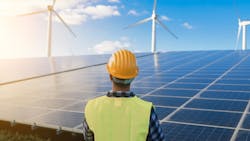Distributed-energy strategies and how manufacturers can operate as their own mini-utilities
Distributed energy resources (DERs) are empowering smart manufacturing in myriad ways. They offer industrial companies greater control over their energy consumption and they enable real-time adjustments to production schedules to efficiently meet shifting production demands.
Manufacturers can take advantage of otherwise unusable/wasted space or processes for the purpose of generating electricity; rooftops and parking lots can house solar arrays, which themselves can be used to shade employee and visitor vehicles. Waste heat, in another example, can be used for co-generation.
See also: When stakeholders speak ESG, 'smart' utilities listen and evolve
All these aspects of DERs contribute to greater efficiency, greater sustainability, and greater profits for manufacturers who implement them properly.
The distributed-energy approach is adoptable by most manufacturing verticals, but particularly appropriate for industries with high energy consumption—think heavy manufacturing, automotive, and chemical production. These fields can greatly capitalize on DER benefits including reducing energy costs, increasing energy resilience, and improving environmental sustainability.
Manufacturing sectors with frequent periods of peak energy consumption, even if only periodic, can benefit from the addition of local energy storage to significantly reduce their peak-power demands from utilities. They can take control of their own power.
See also: Three ways to jump-start your energy-efficiency initiative
Are there challenges to launching a DER strategy for manufacturers large and small? Of course. Upfront costs deter some projects. Many struggle with regulatory uncertainty—how does this work with my local regulatory requirements?
And while the evolving market offers significant opportunities for manufacturers to participate, it also requires technical expertise to do so, generally in the form of a dedicated energy-management team who understands the logistics of installing and maintaining energy resources on-site, rather than the traditional approach of just tapping into the local grid.
Yet this trend is picking up speed. Adoption is accelerating due to cost reductions in renewable-energy technologies and DERs assets (think solar and electric vehicles). Environmental awareness among manufacturers and the customers they serve is increasing and people are demanding these smarter, more energy-efficient approaches. As both local energy generation and storage costs fall, it becomes more advantageous for manufacturers to invest in these capabilities.
See also: Hybrid twins: Antidote to the post-pandemic product recall crisis
Manufacturing decision-makers considering adopting the DERs approach can find guidance from utilities, which have been early, enthusiastic adopters of distributed-energy approaches.
Both sectors face similar challenges in balancing energy supply and demand while ensuring reliability and cost-effectiveness. Manufacturers and utilities can share lessons on grid management, demand response, and integrating renewable-energy sources.
In many ways, operating a manufacturing facility with on-site energy generation is like managing your own mini-utility.
Many of the same processes and technologies are in play. It’s critical that both sides—industry and energy—share information, precautions and best practices to ensure the safe and reliable operations of both distributed assets as well as the utility grid; this can open up many more pathways to collaboration (voltage/reactive power support, pre-emptive islanding, frequency response, etc.).
With a smart, strategic DERs approach, along with guidance from the utilities sector, manufacturers can, quite literally, take control of their power.
About the Author

Harneet Kaur
Harneet Kaur is the energy and sustainability project manager at HEXstream, a Chicago-based company focused on solving data and analytics-related business problems for utilities and other clients.
